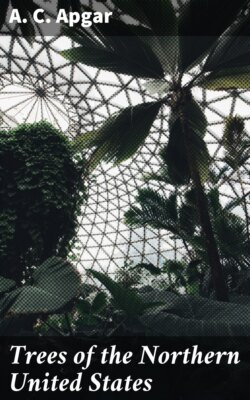Читать книгу Trees of the Northern United States - A. C. Apgar - Страница 12
На сайте Литреса книга снята с продажи.
Chapter VI.
The Preparation of a Collection.
ОглавлениеTable of Contents
Fig. 16.
Three specimens are needed of each kind of tree: one, a branch showing the flowers; another, showing the fruit—one of these, and in many cases both, will show the leaves. The third specimen, cut from a large limb or trunk, shows the bark and the wood. This should be a specimen with a surface so cut as to show the wood in the direction of the silver grain, radial section; with another surface cut in the direction of the annual layers, tangential section; and with a third cut across the grain, cross-section. It should be a specimen old enough to show the change of color in the heart-wood. By taking a limb or trunk 8 inches in diameter, all these points can be secured. A specimen cut as shown in the figure will illustrate all the desired points. Side E F G shows sap-and heart-wood in tangential section; side A B D C shows the same in radial section; end A B F E, in cross-section; and B F G D shows the bark. The central pith is at I; the heart-wood extends from C to J; the sap-wood from J to D. The silver grain is well shown at the end, and the blotches formed by it on the radial section.
By having the piece made smooth, and the upper part down to the center (H) varnished, the appearance of the wood in furniture or inside finish will be illustrated.
The specimens should be as nearly uniform in size as possible. If a limb 8 inches in diameter be taken and a length of 6 inches be cut off, the section A B D C should pass through the line of pith; the section E F G should be parallel with this at a distance from it of two inches; and two inches from the line of pith, the section A E C should be made. The whole specimen will then be 6 inches wide and long, and 2 inches thick.
The twigs containing leaves, flowers and fruit need to be pressed while drying in order that they may be kept in good form and made tough enough to be retained as specimens. The plants should be placed between a large supply of newspapers, or, better still, untarred building-felt, while drying. A weight of from 40 to 80 pounds is needed to produce the requisite pressure. The weight is placed upon a board covering the pile of plants and paper. On account of the size of many leaves and flower-clusters, these pressed specimens of trees should not be shorter than from 12 to 15 inches, and even a length of 18 inches is an advantage. The pads or newspapers should be about 12 by 18 inches. A transfer of the plants into dry pads each day for a few days will hasten the drying and increase the beauty of the specimens. The specimens of twigs can be mounted on cardboard by being partly pasted and partly secured by narrow strips of gummed cloth placed across the heavier portions. The cardboard should be uniform in size. One of the regular sizes of Bristol-board is 22 by 28 inches; this will cut into four pieces 11 by 14. Specimens not over 15 inches in length can readily be mounted on these, and for most collectors this might be a very convenient size. Another regular size is 22 by 32 inches, cutting well into pieces 11 by 16. Specimens 15 to 18 inches long can be mounted on these.
Some kinds of Evergreens, the Spruces especially, tend to shed their leaves after pressing. Such kinds can in most cases be made to form good specimens without pressing. Fasten the fresh specimens on pillars of plaster in boxes or frames 2 to 3 inches deep, so that they touch nothing but the column of plaster. Mix calcined plaster in water (as plasterers do), and build up a column high enough to support the branch. Place the specimen on the top of the pillar already formed, and pour over the whole some quite thin plaster till a rounded top is formed completely fastening the specimen. If the leaves are not touched at all, after they are dry, they will hang on for a long time, making specimens that will show the tree characteristics better than pressed specimens possibly could.
